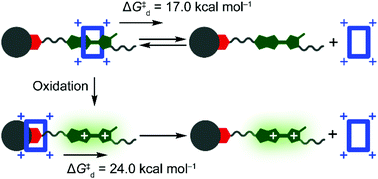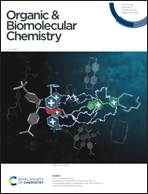Quantifying the barrier for the movement of cyclobis(paraquat-p-phenylene) over the dication of monopyrrolotetrathiafulvalene†
Abstract
A bistable [2]pseudorotaxane 1⊂CBPQT·4PF6 and a bistable [2]rotaxane 2·4PF6 have been synthesised to measure the height of an electrostatic barrier produced by double molecular oxidation (0 to +2). Both systems have monopyrrolotetrathiafulvalene (MPTTF) and oxyphenylene (OP) as stations for cyclobis(paraquat-p-phenylene) (CBPQT4+). They have a large stopper at one end while the second stopper in 24+ is composed of a thioethyl (SEt) group and a thiodiethyleneglycol (TDEG) substituent, whereas in 1⊂CBPQT4+, the SEt group has been replaced with a less bulky thiomethyl (SMe) group. This seemingly small difference in the substituents on the MPTTF unit leads to profound changes when comparing the physical properties of the two systems allowing for the first measurement of the deslipping of the CBPQT4+ ring over an MPTTF2+ unit in the [2]pseudorotaxane. Cyclic voltammetry and 1H NMR spectroscopy were used to investigate the switching mechanism for 1⊂CBPQT·MPTTF4+ and 2·MPTTF4+, and it was found that CBPQT4+ moves first to the OP station producing 1⊂CBPQT·OP6+ and 2·OP6+, respectively, upon oxidation of the MPTTF unit. The kinetics of the complexation/decomplexation process occurring in 1⊂CBPQT·MPTTF4+ and in 1⊂CBPQT·OP6+ were studied, allowing the free energy of the transition state when CBPQT4+ moves across a neutral MPTTF unit (17.0 kcal mol−1) or a di-oxidised MPTTF2+ unit (24.0 kcal mol−1) to be determined. These results demonstrate that oxidation of the MPTTF unit to MPTTF2+ increases the energy barrier that the CBPQT4+ ring must overcome for decomplexation to occur by 7.0 kcal mol−1.

- This article is part of the themed collection: Supramolecular chemistry in OBC


 Please wait while we load your content...
Please wait while we load your content...